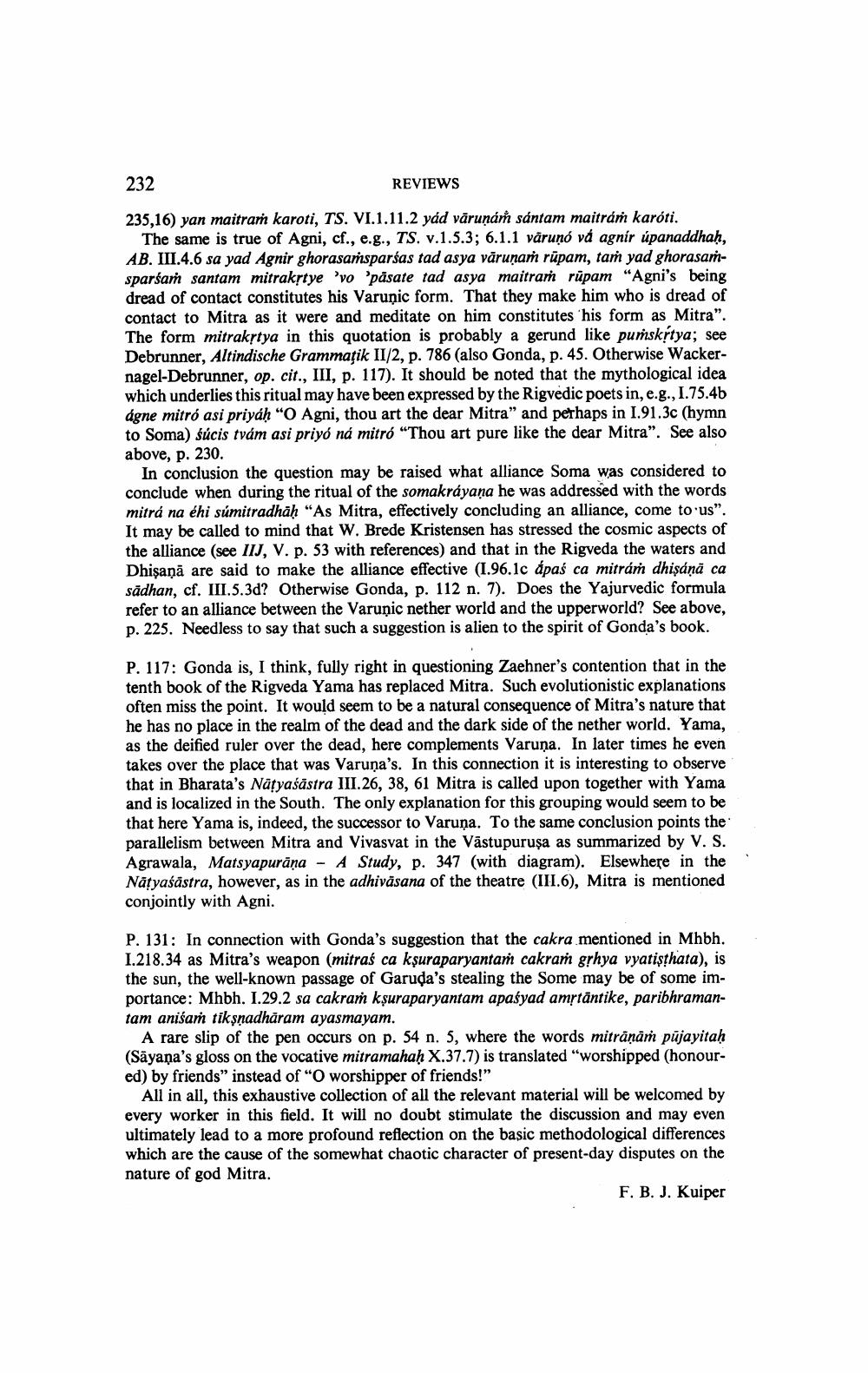________________ 232 REVIEWS 235,16) yan maitram karoti, TS. VI.1.11.2 yad varunar santam maitram karoti. The same is true of Agni, cf., e.g., TS. v.1.5.3; 6.1.1 varuno va agnir upanaddhah, AB. III.4.6 sa yad Agnir ghorasamsparsas tad asya varunam rupam, tam yad ghorasamsparsam santam mitrakrtye 'vo 'pasate tad asya maitram rupam "Agni's being dread of contact constitutes his Varunic form. That they make him who is dread of contact to Mitra as it were and meditate on him constitutes his form as Mitra". The form mitrakrtya in this quotation is probably a gerund like pumskrtya; see Debrunner, Altindische Grammatik II/2, p. 786 (also Gonda, p. 45. Otherwise Wackernagel-Debrunner, op. cit., III, p. 117). It should be noted that the mythological idea which underlies this ritual may have been expressed by the Rigvedic poets in, e.g., 1.75.4b agne mitro asi priyah "O Agni, thou art the dear Mitra" and perhaps in I.91.3c (hymn to Soma) sucis tvam asi priyo na mitro "Thou art pure like the dear Mitra". See also above, p. 230. In conclusion the question may be raised what alliance Soma was considered to conclude when during the ritual of the somakrayana he was addressed with the words mitra na ehi sumitradhah "As Mitra, effectively concluding an alliance, come to us". It may be called to mind that W. Brede Kristensen has stressed the cosmic aspects of the alliance (see IIJ, V. p. 53 with references) and that in the Rigveda the waters and Dhisana are said to make the alliance effective (1.96.lc apas ca mitram dhisana ca sadhan, cf. III.5.3d? Otherwise Gonda, p. 112 n. 7). Does the Yajurvedic formula refer to an alliance between the Varunic nether world and the upperworld? See above, p. 225. Needless to say that such a suggestion is alien to the spirit of Gonda's book. P. 117: Gonda is, I think, fully right in questioning Zaehner's contention that in the tenth book of the Rigveda Yama has replaced Mitra. Such evolutionistic explanations often miss the point. It would seem to be a natural consequence of Mitra's nature that he has no place in the realm of the dead and the dark side of the nether world. Yama, as the deified ruler over the dead, here complements Varuna. In later times he even takes over the place that was Varuna's. In this connection it is interesting to observe that in Bharata's Natyasastra III.26, 38, 61 Mitra is called upon together with Yama and is localized in the South. The only explanation for this grouping would seem to be that here Yama is, indeed, the successor to Varuna. To the same conclusion points the parallelism between Mitra and Vivasvat in the Vastupurusa as summarized by V. S. Agrawala, Matsyapurana - A Study, p. 347 (with diagram). Elsewhere in the Natyasastra, however, as in the adhivasana of the theatre (III.6), Mitra is mentioned conjointly with Agni. P. 131: In connection with Gonda's suggestion that the cakra mentioned in Mhbh. 1.218.34 as Mitra's weapon (mitras ca ksuraparyantam cakram glhya vyatisthata), is the sun, the well-known passage of Garuda's stealing the Some may be of some importance: Mhbh. I.29.2 sa cakram ksuraparyantam apasyad amstantike, paribhramantam anisam tiksnadharam ayasmayam. A rare slip of the pen occurs on p. 54 n. 5, where the words mitranam pujayitah (Sayana's gloss on the vocative mitramahah X.37.7) is translated "worshipped (honoured) by friends" instead of "O worshipper of friends!" All in all, this exhaustive collection of all the relevant material will be welcomed by every worker in this field. It will no doubt stimulate the discussion and may even ultimately lead to a more profound reflection on the basic methodological differences which are the cause of the somewhat chaotic character of present-day disputes on the nature of god Mitra. F. B. J. Kuiper




